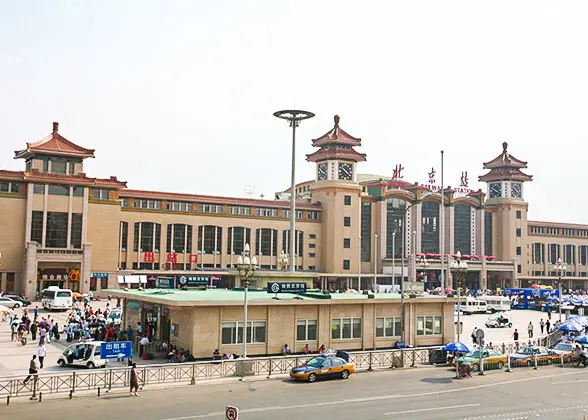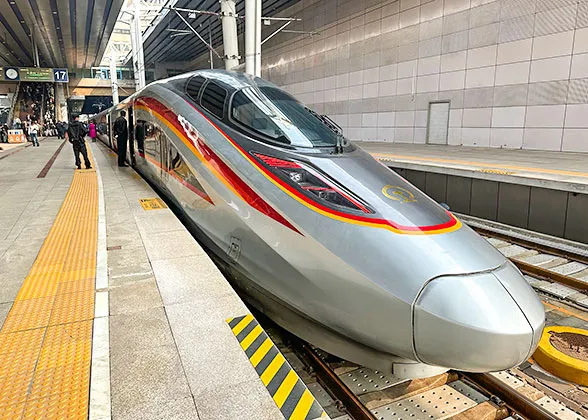Beijing Transportation
Beijing is the most important transportation hub in mainland China in air, rail and road transportation: China’s busiest airports are located here; it is the biggest rail hub of the country; many national roads and expressways radiate out here. Its urban area also has well-appointed transport system. However, as a metropolis in a densely populated country, transportation in the city’s urban area is a bit crowded, especially during rush hours (around 08:00 and 18:00). During these time periods, traffic jams are common and may cause significant delays. If possible, avoid taking buses/taxis at this time of a day as it may drain your limited vacation time and take subway as the first choice.
How to Get to Beijing
Air
There are two passenger airports in Beijing: Capital International Airport in the northeast of the city, about 25 kilometers (about 16 miles) from Tiananmen Square and Daxing Airport, about 53 kilometers (33 miles) south of Beijing city center. They both serve domestic and international flights; so double confirm which airport you are going to use, especially when departing from the city. Both the airports can be easily reached by airport shuttle bus, express subway train and taxi. There are also long-distance buses connecting the airports with nearby cities like Langfang and Baoding.
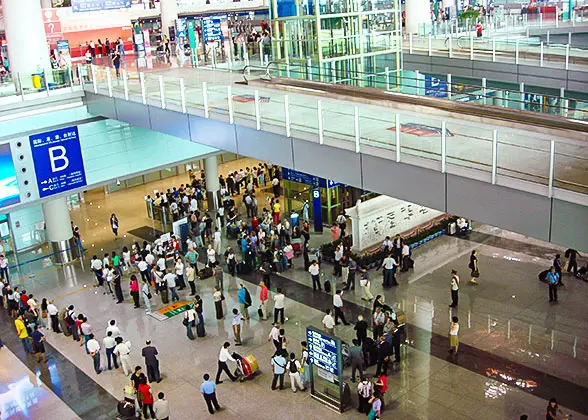 |
| Capital Airport |
![]() Terminal 2
Terminal 2![]() Terminal 3 - Transfer in T3
Terminal 3 - Transfer in T3![]() Facilities & Services of T3
Facilities & Services of T3![]() 5 Things to Do
5 Things to Do![]() Airport Maps
Airport Maps![]() Airport Express Train
Airport Express Train![]() Airport Shuttle Bus to Downtown
Airport Shuttle Bus to Downtown
Daxing Airport
|
|
As one of the busiest long-distance bus transport hubs, Beijing has 8 coach stations operating buses to neighboring cities like Tianjin, Zhangjiakou ... There are ten major ones in downtown, including Liuliqiao Passenger Transportation Junction, Zhaogongkou Bus Station, Sihui Bus Station ……
Transportation to Major Destinations
![]() How to Travel between Beijing and Shanghai: Train vs. Plane
How to Travel between Beijing and Shanghai: Train vs. Plane
![]() How to Travel between Beijing and Guangzhou: Train vs. Plane
How to Travel between Beijing and Guangzhou: Train vs. Plane
![]() How to Travel between Beijing and Xi'an: Train vs. Plane
How to Travel between Beijing and Xi'an: Train vs. Plane
![]() How to Travel between Beijing and Hong Kong: Train vs. Flight
How to Travel between Beijing and Hong Kong: Train vs. Flight
Transportation to Other Cities
- Great Wall of China
- Tianjin
- Zhangjiakou
- Guilin
- Guiyang
- Shenzhen
- Dalian
- Wuhan
- Shenyang
- Zhangjiajie
- Zhengzhou
- Lhasa
- Chongqing
- Fuzhou
- Changsha
- Nanjing
- Hangzhou
- Harbin
- Jinan
- Qingdao
- Chengdu
- Suzhou
How to Get around Beijing
At present, 29 subway lines have been in operation, including two airport express lines and two tram lines. Due to the frequent traffic jams, the subway is the most time-saving transport means especially during rush hours.
Check out each subway line to know its route and schedule to better plan your trip.
| Subway Lines | Major Stops / Attractions / Landmarks |
| Line 1 | Military Museum, Tian’anmen Square, Forbidden City, Wangfujing Commercial Street, Universal Studio |
| Line 2 | Beijing Railway Station, Qianmen, Dongzhimen, Lama Temple |
| Line 3 | Chaoyang Park, Chaoyang Railway Station |
| Line 4 | Old Summer Palace, Summer Palace, National Library, South Railway Station |
| Line 5 | Temple of Heaven, Lama Temple, Beixinqiao of Capital Airport Express |
| Line 6 | Nanluoguxiang, Shichahai, Beihai Park |
| Line 7 | Universal Studio, Beijing West Railway Station, Lianhuachi Park |
| Line 8 | Bird’s Nest, Water Cube |
| Line 9 | Chaoyang Park, Sanlitun, Ethinic Cultural Park |
| Line 10 | Fengtai Railway Station |
| Line 11 | Shijingshan Park |
| Line 12 | Big Bell Temple, Renmin University |
| Line 13 | Big Bell Temple, Qinghe Railway Station, Dongzhimen |
| Line 14 | Chaoyang Park, South Railway Station |
| Line 15 | Olympic Park |
| Line 16 | National Library, Fengtai Railway Station |
| Line 17 | Shilihe, Jiahuihu |
| Line 19 | Caoqiao of Daxing Airport Express Train |
| Changping Line | Ming Tombs (Changping Stop) |
| Yizhuang Line | Songjiazhuang, Yizhuang Railway Station |
| Fangshan Line | Liangxiang University Town |
| Yanfang Line | Yancun East, Yanshan |
| Line S1 | Pingguoyuan, Shichang |
| Capital Airport Express | Capital Airport |
| Daxing Airport Express | Daxing Airport |
| Xijiao Line | Fragrant Hill Park (Xiangshan) |
| Yizhuang T1 Line | Dinghaiyuan, Laoguanli |
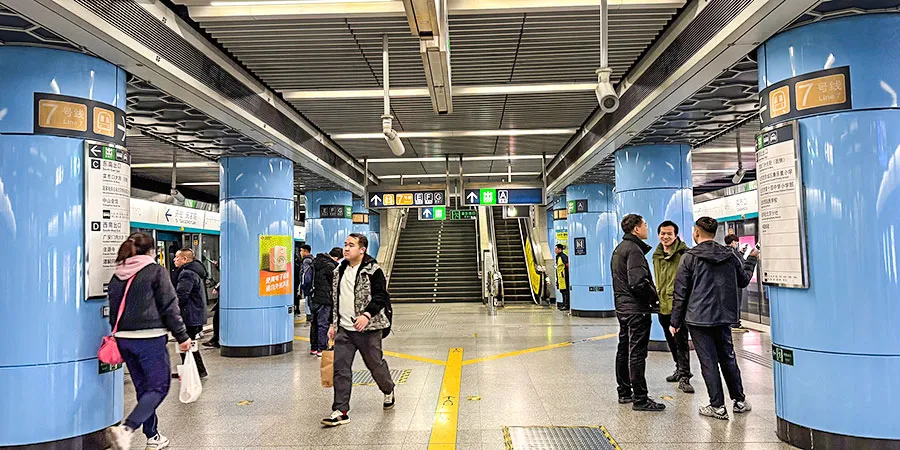 |
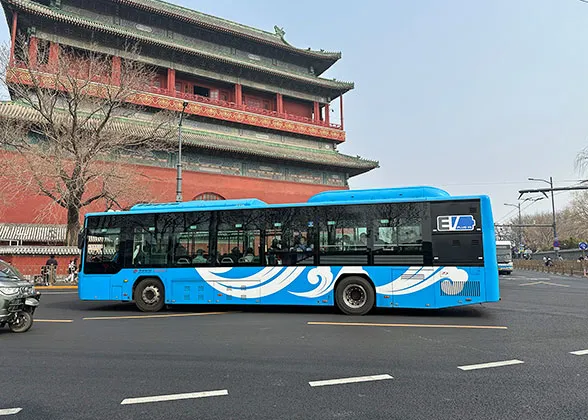 |
Over 2,200 bus routes are running in Beijing, including regular downtown lines, suburban lines, night lines and intercity lines. Dangdang sightseeing buses from Forbidden City go through Beijing Central Axis on UNESCO World Heritage List; tourist buses from transportation hubs like Dongzhimen or Deshengmen run to attractions in suburban areas like Yanqi Lake; direct buses run by Beijing Hub of Tour Dispatch from Qianmen to Badaling and Mutianyu Great Wall are super convenient.![]() Hub of Tour Dispatch
Hub of Tour Dispatch![]() Sightseeing Bus
Sightseeing Bus![]() Beijing Tourist Bus
Beijing Tourist Bus
Taxi & DiDi for Ride-Hailing
About 67,000 taxis are in operation in Beijing with the flag-down rate of CNY13 for the first 3km (2mi). The drivers would charge by meter for downtown travels, and ask for flat rates for long-distance trips.
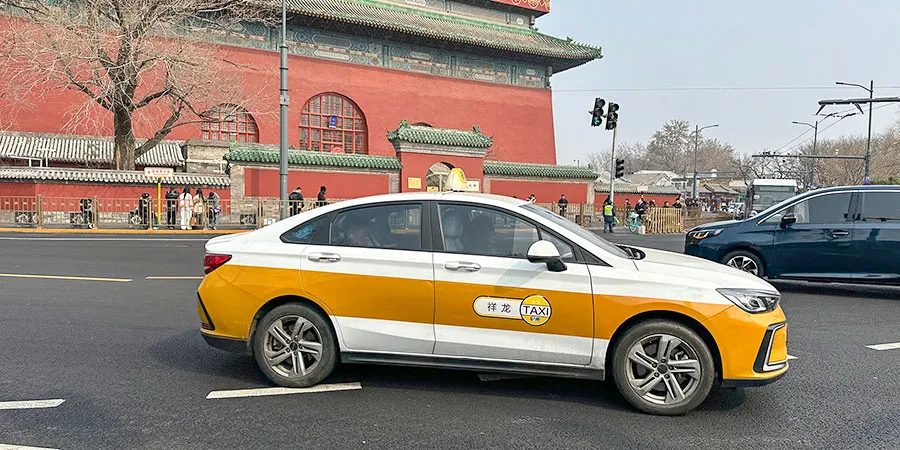 |
Considering that hailing an open taxi during rush hours may be a challenge and taxi drivers also take orders online, DiDi, the most popular ride-hailing app in China known as Uber in China, is the first choice for its efficient and cheaper price which supports international numbers and major international credit cards like MasterCard and VISA.
After hailing a car, all the conversation passengers need to do with the drivers is to report the last four digits of the number which they can easily understand even in English, and of course Xie Xie while getting off the car. Passengers can also send messages to the driver which will be automatically translated into Mandarin on drivers’ DiDi app, no language barrier at all. Passengers can download DiDi or attach to its mini program on Alipay, the most useful app in China.
940,000 dockless sharing bikes run by DiDi Bike, Hello Bike and Meituan Bike are good supplements to the mass transit of Beijing city buses and subways. Internet access and mobile apps are a must to use these dockless bikes and they accept online payment by Apple Pay, Wechat Pay or Alipay.
Rickshaw
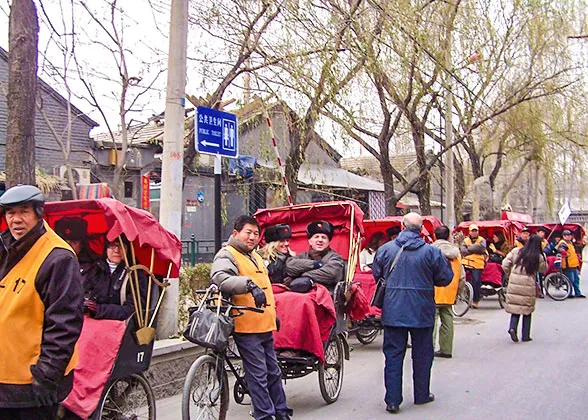 |
Rickshaw is a traditional form of transport. Nowadays, modern rickshaw travel is an excellent way to experience old Beijing culture and Hutongs (alleyways). After paying a negotiated fare, the rickshaw pullers will take you through the narrow lanes. Tourists can find the rickshaws at attractions like Nanluoguxiang, Shichahai and Houhai. The price is CNY100-200 depending on the duration and sometimes the extra service fee is charged. It is recommended to bargain for an exact price before boarding.
Navigation of Beijing Public Transportation
Amap, the international version of Gaode Map, is designed for international travelers which makes navigations easier for foreigners in Beijing. Offering real-time bus and subway information even with which exit to take and walking directions, it is the best public transport route planner which saves time and money. DiDi mini program on Alipay also shows accurate location, surroundings and directions well.
Google Map used by most global tourists is not reliable in China as it has inaccurate location data with no update. Apple Maps does not work in China.
MetroMan is also the choice for metro route planning in Beijing and there are 10 language options. Passengers can download data and use it offline.
Payment for Beijing Public Transportation
Transportation Smart Card & Beijing Pass for Foreign Travelers
There are two types of Beijing smart transportation card, Beijing Yikatong Card and Beijing Hutong Card with “China T-Union” that can be used in over 300 cities in China. Users can take their passports and go to the customer service centers of subway stations to apply for a deposit card. To top up the physical card, users can go to the service centers and self-service machines at subway stations.
Beijing Pass priced at CNY 20 is a functional top-up card for foreign travelers in Beijing to use public transportation, buy entrance tickets for up to 30 attractions like Temple of Heaven, Ming Tombs and Summer Palace. It can be purchased on self-service machines at Capital Airport, Daxing Airport, train stations and the service office at Dongzhimen or Xidan. Top-up is available at manual service centers and on machines of all subway stations, or on SilkPass App. Marked with China T-Union like Yikatong, it can also be used in over 300 cities in China.
Beijing Pass cannot be returned and tourists can keep it as a souvenir as physical cards are always designed with distinct China features.
Alipay and WeChat, two apps that are widely used in China, provide the best service for daily life, certainly including payment for public transportation. Tourists can easily find Beijing transportation mini programs, get a QR code to take buses and subways by scanning it. Remember to link your credit card to it beforehand for automatic checkoff.
Simply Tap Your MasterCard or VISA to Take Beijing Subway
All subways stations of 17 lines has equipped with gate machines accepting international cards including MasterCard, VISA and UnionPay. Passengers can also buy tickets or day pass with international cards on ticket vendors or at manual service center.
What Transport methods to Choose?
Convenient Subway to Ensure Your Trip
The Beijing subway is always the first choice for tourists as it can reach almost all the famous attractions in Beijing. As a populous metropolis, ground transportation is inevitably congested, so the subway is the best choice to ensure your trip as it is punctual with short intervals and easy to transfer within the stations without navigation. If you have a tight schedule, the subway is the best choice.
Online-hailing Cars for Short Distance
Beijing has a large number of online hailing cars and the price is favorable compared to taxis. If you take big luggage and would like a more comfortable ride or the destination is not far, online hailing cars are very cost-effective; also, it is better for a small group or a family for members can split the fare.
City Bus: Budget for Ground Sceneries but with Language Barrier
City buses are the cheapest and some city buses like no. 5 actually function as sightseeing buses going through the central axis. But overall it is not recommended as the stops are all labeled in Chinese with Pinyin, which can be confusing for foreign tourists so you may get off at the wrong stop. Moreover, sometimes you have to walk to another stop for a transfer.
Ride a Sharing Bike to Finish the Last Mile
Subway + sharing bike often make the best transportation options. When your destination is still a little bit far from a subway exit, there are usually shared bikes at subway exits, unlock one to free up your legs. You can also ride a bike for a leisurely sightseeing tour along Beijing’s Central Axis, or experience local lifestyle by shuttling between hutongs.
Rickshaw for an Authentic Hutong Tour
Rickshaw tours are the best way to experience hutong culture. Pretend to be an old Beijing citizen and experience authentic Beijing life on the nostalgic rickshaws.
